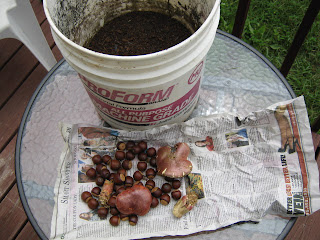Here it is August again, and in a few more weeks, oak trees everywhere are going to be sending off their offspring (acorns) to start the next generation. They get a little bit of help from squirrels in their seed dispersal, but they can always use more. In that spirit, I'm starting this thread for those of you who would like to see more oak forested areas. Of course, you could get some seedling trees from your state forestry commission (here in Georgia, they start at $27 for 10 seedlings and have deep discounts if you buy in volume) and plant them in late winter, but it is more in keeping with the Fukuoka style of permaculture to put out a lot of acorns and let Nature find the best places for them to thrive.
The key thing to recognize about the oak genus,
Quercus, is that it is highly dependent on mycorrhizae for its growth and development. And this is evident as soon as the root breaches the hull of the acorn. Very often the tap root will be a foot long before the two cotyledons peek above the surface. If that tap root has found a mycelial network to support it, the seedling will thrive, if not, survival may just be so-so.
Now this post is not an advertisement for some mycorrhizal inoculant product that you can buy at a premium price. What I am going to do here is to show you how to collect, inoculate, and plant your acorns with no cash investment on your part (well unless you want to buy a bag of potting soil). This is my 3-bucket method.
Bucket number 1: For your collected acorns. I like to shake the tree branches to dislodge the ripe ones. Acorns on the ground soon fall victim to all sorts of critters, not to mention cars driving by. Inspect your acorns for little tiny holes made by curculio worms. I have found that on live oak trees in this area, more than half the acorns have a curculio worm that has taken up residence.
Bucket number 2: For your collected mushrooms. Any
bolete will do, if you are careful in your collecting and select edible ones, then when your oak matures, the ground under it will be a reliable source of edible mushrooms. If you have a real long-term view to your permaculture, obtain a sample of the
Tuber genus, and turn your future oak forest into a truffle hunting ground. Boletes are an order of mushrooms that are distinguished by having a spongy, tube like structure under their cap instead of gills. One of the rules of bolete collecting is that if this sponge turns blue when you bruise it, it is an inedible mushroom. With my luck, all the boletes at my local hunting ground bruise blue.
Bucket number 3: Fill it halfway with rich potting soil or
compost and add your acorns. Take the mushrooms your have collected and put them through the blender with enough water so that you have a thin mushroom gazpacho. Now stir that in with your acorns and soil. You can leave bucket number 3 to sit for quite a while, letting the fungal inoculate perfuse throughout the media.
Here's a picture from when I was developing this method and could only afford one bucket, so I replaced buckets number 1&2 with a sheet of newspaper:

If you let bucket #3 sit through the winter, you will have lots of oak seedlings to untangle the following spring. The alternative is to go out and play squirrel yourself, burying each acorn with a trowel full of inoculated soil. What I don't recommend is the guerrilla gardening trick of mixing it with heavy clay soil and letting it dry out. Having it dry out is going to be hard on both the acorn and the fungi. You want to keep your bucket of soil and acorns moist, or you want to get them into the ground and mulch then with some leaf litter to get your best results.
Happy planting!



